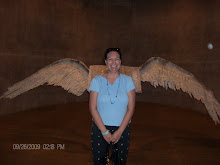Sunday, April 5, 2009
Stations
Hello www,
Heavenly Father bless, guide and help everyone in the world looking for work, for all marriages, for all engagements, for singles everywhere, for everyone I said I would pray for, and thanks for all the blessings you bestow upon each of us. In Jesus' name. Amen.
I can't possibly leave out mentioning the Stations of the Cross before Lent ends this coming Easter Sunday.
I've always thought the Stations are the most thought provoking, reflective prayer we have as Catholics, and for some reason this Lenten season they seemed even more so, and I can't really say why, other than I feel God opened my eyes to concentrate more on them AND to Digest what I'm praying...
For those of us who are Catholic but don't know much background history about the stations, I'm posting some info I found on http://www.newadvent.org/cathen/15569a.htm and for those of my readers who aren't Catholic, my hope is to introduce you to this wonderful prayer.
*inhaling*Okay, here goes:
Way of the Cross
(Also called Stations of the Cross, Via Crucis, and Via Dolorosa). These names are used to signify either a series of pictures or tableaux representing certain scenes in the Passion of Christ, each corresponding to a particular incident, or the special form of devotion connected with such representations.
They are usually ranged at intervals around the walls of a church, though sometimes they are to be found in the open air, especially on roads leading to a church or shrine. In monasteries they are often placed in the cloisters. The erection and use of the Stations did not become at all general before the end of the seventeenth century, but they are now to be found in almost every church. Formerly their number varied considerably in different places but fourteen are now prescribed by authority. They are as follows:
1. Christ condemned to death;
2. the cross is laid upon him;
3. His first fall;
4. He meets His Blessed Mother;
5. Simon of Cyrene is made to bear the cross;
6. Christ's face is wiped by Veronica;
7. His second fall;
8. He meets the women of Jerusalem;
9. His third fall;
10. He is stripped of His garments;
11. His crucifixion;
12. His death on the cross; (a longer pause is given at this station, of course, and when you are meditating on the other stations and then come to this one and pause, it is Very Powerful)
13. His body is taken down from the cross; and
14. laid in the tomb.
The object of the Stations is to help the faithful to make in spirit, as it were, a pilgrimage to the chief scenes of Christ's sufferings and death, and this has become one of the most popular of Catholic devotions. It is carried out by passing from Station to Station, with certain prayers at each and devout meditation on the various incidents in turn. It is very usual, when the devotion is performed publicly, to sing a stanza of the "Stabat Mater" while passing from one Station to the next.
The short phrases from Stabat Mater enhance the devotion. Everything about the stations comes together.
In another entry I will attach pictures of the Stations of the Cross. If you feel moved by the spirit, you can pray the stations right now at http://www.ourcatholicfaith.org/stations/menu.html.
(Interesting to note, at school the students are given 'stations' - work to do either at their desks or on the computer - so now when I say "Here are your stations," it will take on an added meaning.)
May God continue to be felt long after Lent has passed us, and may the lessons we've learned during Lent stay with us and be an inspiration for our behavior the rest of the year.
Gaaaahd bless us!
Subscribe to:
Post Comments (Atom)






No comments:
Post a Comment